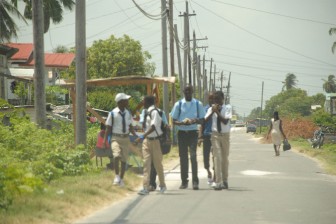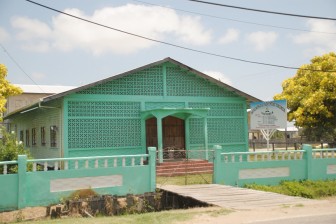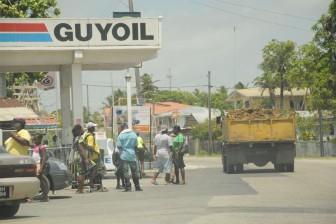By Leyland Lucas, PhD,
Donald Ainsworth, MA,
Rawle Lucas, MA, CPA,
Sheranne Doorgasingh Wickham, M. Sc.
Background
In November 2009, The Friends of Victoria Diaspora Inc., an organization made up of Victorians and descendants of Victorians based in the New York area, held the 170th Commemorative Anniversary of the purchase of the village by the 83 Ancestors. The cultural performances were of such a high standard and the organization outstanding.
There was a keen awareness that many challenges face the village in such areas as education, employment, access to capital to enhance economic activity; declining social and moral standards; a lack of facilities for youth, and general neglect of the village.
The challenges were manifest in the losses suffered during the floods of 2005 and 2006. Prior to the floods floods, Victorians in the diaspora sought to support the village though the uncoordinated nature of their efforts meant that these impacted minimally on the the village. The flood response revealed diaspora aid, including worker remittances, needed to be better organized to optimize its benefits. It was during this period that Rawle Lucas became a member of the group, bringing with him experiences gained working for UNICEF among rural communities in Bangaladesh and Ethiopia, and Desmond Saul, Chairman of the Victoria Reconstruction. The dialogue was subsequently broadened to include, Dr. Kenrick Hunte, a Professor at Howard University and a former General Manager of GAIBANK, and Dr. Leyland Lucas, Professor at Morgan State University and Director of the University’s PhD Programme in Business Administration.

Agreement was eventually reached on the hosting of an annual Indaba (conference). To ensure that the widest perspectives were available, Abraham Poole, a Communication Expert with roots in Victoria was recruited to the project; So too were Dale Callender, Sheranne Wickham, Milford Lewis, and William Henry who is based in Canada.
To date, two conferences referred to as the “First-Village Indaba” have been held. These have ignited passions in the village about its future. The high level of energy on display enabled the Indaba to reach important conclusions about improving conditions in the village. The first Indaba, held from August 5 to 8, 2010, adopted 15 resolutions, many of which called for action to improve conditions in the Village. Victoria got the National Assembly to support unanimously, on May 19, 2011, a series of actions designed to improve the economic and social conditions of the village. The Petition also recognized the significance of Victoria to the “Village Movement” and hence the development of Guyana.
Victoria must confront development opportunities emerging from the Petition including job-creation, environmental sustainability, revitalizing agriculture, and developing human resources, technology and the infrastructure in preparation for the hosting of a national agricultural exhibition in 2014. Economic opportunities also repose in the restoration and preservation of the village’s historical artifacts and the erection of a monument in honour of the 83 founders of the village. In this regard several public/private sector initiatives are planned Arising out of the second Indaba, held from August 4 to 7, 2011, the village also needs to address the state of the community centre and the primary school, road safety risks arising from street design and various environmental challenges. .
Information and Communication

The ICT sector in Guyana has undergone major change within the last two decades. When Guyana Telephone and Telegraph Company (GT&T) began operations in Guyana in 1991, there were about 13,000 fixed access lines in the country and 1,000 customers using cellular service within a 30-mile radius. After 19 years, fixed access lines grew to 150,000 and demand for mobile phone usage had reached 309,000. These changes increased the opportunities for villages like Victoria.
Most of the investment has come through Digicel and GT&T which have been esponsible for about 34 percent of foreign direct investment in Guyana between 2005and 2007. ICT now accounts for seven percent of gross domestic output (GDP). The telecommunication infrastructure has been further strengthened with the construction and deployment by GT&T in July 2010 of an undersea fiber-optic cable link between Guyana and Suriname. That infrastructure will be bolstered by a cross-border link between Brazil and Guyana as part of public sector investment in ICT.
Across Guyana businesses rely on ICT for managing their enterprises Commercial banks have introduced online banking services. The Internet Café has become a major small business investment. The introduction of Guyana Trade Point, an Internet market access tool for small and medium sized businesses, was possible because of the upgrade in ICT. Small businesses in Victoria which might have found it difficult to explore export markets are now in a position to do so. The influences of ICT changes taking place in Guyana are clearly impacting on life in Victoria. The Victoria Conference Leadership Committee (VCLC) holds virtual meetings weekly with simultaneous participation from North America and Guyana. It enables the VCLC to plan and organize the annual Indaba in real time to better manage information and ensure the timely preparation and dissemination of reports and achievements of the Indaba.
ICT and other non-agricultural pursuits present both opportunities and difficulties with which the core competencies can be employed to the advantage of the village. A response under consideration is how to utilize ICT as a means of attracting the younger generation to agriculture and other legitimate pursuits.
One way to use ICT at the village level is to create jobs, training villagers in the use of the various computer applications and in repairs and maintenance. Another option is to incorporate technology applications into the business tools. With web communication facilities like Skype or Google Talk, invitations to virtual meetings would not require busy shop owners to leave their businesses unattended. Bluetooth technology enables shopkeepers to multi-task.
Importance of Love of Community
Another major issue is the condition of the human resources ofthe village. In addition to the formal school system, work in this area has been taking place through the media of the church, special-purpose entities like the VRT, special arrangements such as the annual education awards to deserving children of the village and other initiatives not connected to the Indaba.
Contemporary efforts at human development have come through special-purpose entities like the VRT. The VRT focuses on training young adults, who are experiencing difficulty reaching their full potential. The numbers are small, but the results are positive with the VRT, over an 8-year span, assisting over 100 students from Victoria and other villages either to obtain life skills or move on to higher education in such areas as agriculture, welding, carpentry, sewing and motor mechanics. The private sector support for this initiative remains a vital ingredient of its success. Their continued input can be seen as a guarantee for the continued uplift of the village. To keep track of its progress and to keep its programme relevant, the VRT has begun the process of recording an inventory of skills in the village and neighbouring areas. It is one way to address the skills gap in a timely manner and avoid the existing consequences of structural unemployment.
The education awards are designed to motivate children to remain in in school and to perform creditably. The annual education awards will continue to serve as a tool to inspire higher and greater educational achievements.
Environmental Sustainability

Victoria is failing its environmental stewardship. William N. Arno once wrote that [Victoria was regarded] “as one of the most thriving communities of the Colony so much so that it came to be best known as the Sweet Auburn of the Coast and Sanatorium of British Guyana on the account of its excellent health conditions Victoria was once considered the most attractive village on the East Coast of Demerara”. The beauty and sheen have left the village and it is now an environmental nightmare. Uncollected and untreated solid waste can be found regularly on the streets since there is no proper waste collection and disposal system. Plastics, cans, paper etc. are dumped on the roadside, on streets and in waterways. The transfer of toxins into the land, ocean and fresh water resources only worsen the pollution problem. Sufficient visual evidence exists to indicate that water contamination is emerging as a major environmental heath issue.
Victoria has begun to respond to the environmental challenges confronting it. the environmental advocate of the VCLC organized and executed a “Clean-Up Day” event on July 30, 2011.
The Role of women in Community Rebirth
Given the prominent role women played in making the purchase of the village a reality, future efforts at revitalizing the village aim to take advantage of the contribution that they can make.
Several women of the village hold senior teaching positions in the public school system. An increasing number of women are also achieving professional qualifications and experience in the health, legal and engineering professions. These accomplishments increase opportunities for strengthening the contribution that women can make to the development of the village.
The Economic Dimension
A primary goal of the Indaba is to improve the economic viability of the village, making it a hub of economic activity on the East Coast Demerara. To do so, the economic development plan will:
Promote a positive identity that positions the village as a business-friendly and environmentally-friendly community, with a high and stable quality of life and create employment opportunities suited to the local labour force;
Identify multiple value-added business opportunities that help to diversify the village economy support small business development, expansion and retention, attract new investment that meets social, environmental and economic objectives, an important dimension of the economic initiative being promoted in the village is based on the existing competencies and capabilities that already exist there.
The village economy
The energies of the young people of the village are not properly applied. A high school dropout rate and lack of access to vocational training have spawned high unemployment and underemployment. Accordingly, the economic plan emphasizes the need to develop a number of skills, development programmes that can help to increase the employment opportunities for the young people of Victoria.
Victoria also seeks to establish relationships with financial institutions. Much of the financial activity occurring within the economy continues to be centered around the cities and specific areas. Yet, there are numerous opportunities for such institutions to establish outlying operations in surrounding communities. Building on ideas operating successfully in other countries, we seek to attract banking services for the local community through ‘mobile banking.’ This model allows for financial institutions to enter communities on specific schedules and service their customers. This is a ‘win-win’ proposition as it reduces the problems of customers having to travel to the city to conduct business, while establishing strong relationships with customers and competitive advantages for the financial institutions. When one considers the opportunity cost (in economic and social terms) of traveling to the city for the primary purpose of conducting simple banking transactions, such an option is vital to our success.
The economic plan also emphasizes the need to identify alternative sources of funding including the reestablishment of a strong cooperative movement within the community. This approach can draw on the experiences of such cooperatives as Kuapa Kokoo™, a successful cooperative built around a product and the concept of improving the economic, social, and political well-being of the community. Such a Cooperative can also facilitate what has come to be known as ‘out-grower agricultural schemes, which are designed to facilitate cooperation between commercial enterprises and small farmers. These schemes also help to diminish the problems of small scale subsistence farming by providing ready markets for the products. Such partnerships could include informal relationships with restaurants to purchase vegetables and other inputs at predetermined prices.
Although we are aware of the importance of infrastructure, education, and training programs to economic success, we recognize that these are not sufficient. Businesses cannot succeed without support. There is need for the creation of a Business Support Centre that can provide access to research and marketing data that are vital to business success.
A major source of economic activity is investment in cash crops. Cash crops require limited capital investment, have a readily available market, and are relatively easy to maintain. Cash crops have facilitated the successful export of peppers, achar, plantain and breadfruit chips and carambola, among others. Consideration should be given to linking the unemployed to producing inputs for already existing businesses within the village.
Of equal importance is the revitalization of previously dormant industries. One initiative under consideration is the revitalization of the honey industry. Conversations with village elders provide a wealth of information on a formerly successful honey-producing industry that has declined, due to mortality and migration. Yet, there remains at least one industry participant. The honey industry carries low overheads and can generate significant income in a short time-period.
Conclusions
The absence of a coordinated development plan and the unavailability of funding have exacerbated the problems confronting Victoria Village and surrounding communities. Reversing these trends in Victoria and other villages in Guyana require that we take an inventory of their economic assets and set goals and objectives by creating appropriate economic development plans.
One cannot emphasize enough the need to focus on the youth as part of the effort to reverse socio-economic trends within Victoria. A recent ILO report suggested that there is a significant link between the level of unemployment among the youth, socio-economic challenges, and cavity discord. As we all know, ‘the devil finds work for idle hands.’
Women too must play a key role in the rebirth of Victoria Village. Being aware of their role and not focusing on their limitations, they can influence the community development outcomes.. Women often play a significant role as agents of change.
Their involvement in sectors such as agriculture, education, health care, the environment and the implementation and utilization of new technology can work to the community’s advantage.
Much hope is also being pinned on the mobilization and strategic use of technical capacity, particularly among successful women from the village, to help lead the efforts at integrating technology into business operations. This will be done through deliberations on a renewed effort to expand food production and sell value-added products, using the agricultural exhibition as a mobilization tool. The integrative approach to competition aims to use an identifiable brand as a franchise leader in food production and agro-processing to aid in expanding food production and the marketing of value-added products. This effort is also expected to be supported by the ICT changes that are taking place in Guyana. Computer and mobile technology applications will be employed in the effort to expand economic opportunities in the village.








